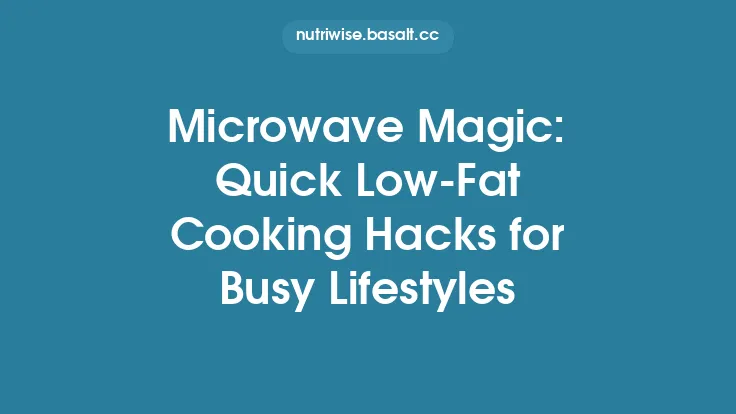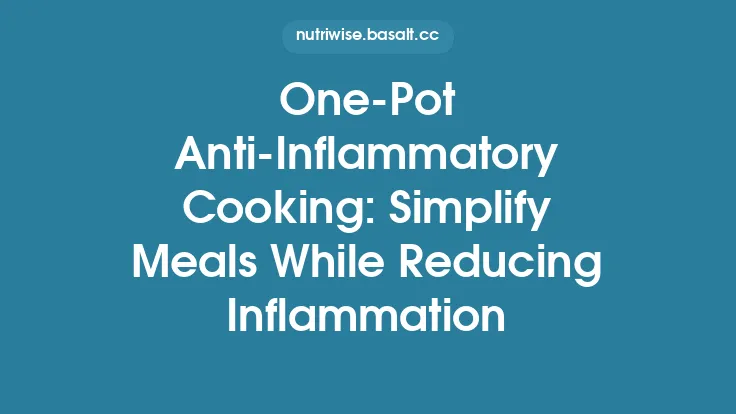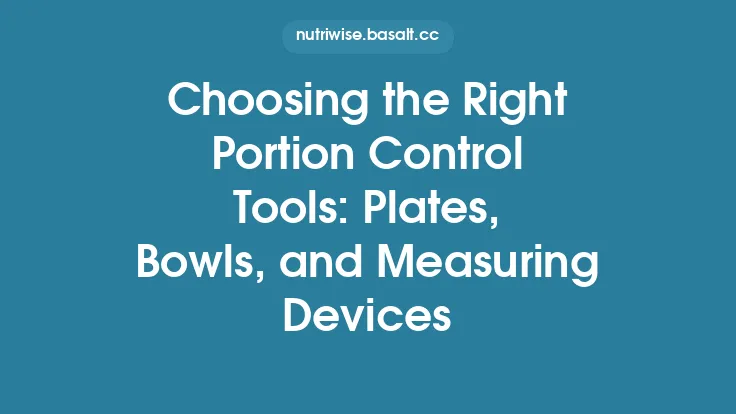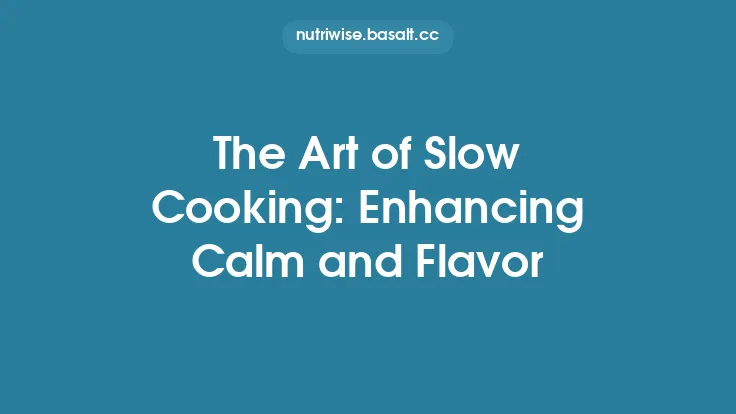Non‑stick cookware has become a cornerstone in kitchens where health‑focused cooking is a priority. By dramatically reducing the need for added fats, it enables the preparation of flavorful dishes while keeping calorie counts low. Yet, the science behind how these pans work—and how to choose the right one for your low‑fat culinary goals—often remains a mystery. This article delves into the material science, heat dynamics, health considerations, and practical guidelines that empower you to make informed decisions about non‑stick cookware, ensuring both optimal performance and safety in your low‑fat cooking repertoire.
Understanding Non‑Stick Coatings
Non‑stick surfaces are engineered to create a low‑energy interface between food and the pan, minimizing adhesion. The most common coatings include:
| Coating Type | Primary Composition | Typical Application Temperature | Notable Characteristics |
|---|---|---|---|
| Polytetrafluoroethylene (PTFE, e.g., Teflon) | Fluoropolymer polymer chains | Up to ~260 °C (500 °F) | Extremely low friction, smooth surface, prone to degradation at very high heat |
| Ceramic‑based (sol‑gel derived) | Inorganic silica‑based matrix | Up to ~230 °C (450 °F) | Hard, scratch‑resistant, free of PTFE and PFOA, can become less non‑stick over time |
| Anodized Aluminum with Non‑Stick Layer | Hard‑anodized aluminum + polymer coating | Up to ~240 °C (464 °F) | Combines excellent heat conductivity of aluminum with a durable surface |
| Silicone‑infused | Silicone particles embedded in a polymer matrix | Up to ~200 °C (392 °F) | Flexible, highly resistant to scratching, often used in bakeware |
The effectiveness of a non‑stick surface depends on the uniformity of the coating, its thickness, and the bond strength to the underlying metal. Modern manufacturing techniques such as plasma spraying and electrostatic deposition improve adhesion, reducing the risk of flaking—a key safety concern.
Heat Transfer and Cooking Efficiency
Low‑fat cooking thrives on precise temperature control. Non‑stick pans influence heat transfer in two major ways:
- Thermal Conductivity of the Base Metal
- Aluminum: Conductivity ≈ 237 W·m⁻¹·K⁻¹, heats quickly and evenly, ideal for delicate foods that require rapid temperature changes.
- Copper: Conductivity ≈ 401 W·m⁻¹·K⁻¹, superior heat distribution but often paired with a stainless steel or aluminum core for durability.
- Stainless Steel: Conductivity ≈ 16 W·m⁻¹·K⁻¹, slower to heat; when used as a core in a multi‑layer pan, it provides a stable cooking surface with reduced warping.
- Insulating Effect of the Coating
While the coating itself is thin (typically 5–15 µm), it can slightly reduce heat flux to the food. However, the impact is negligible compared to the base metal’s conductivity. The real advantage lies in the reduced need for oil: the low surface energy prevents food from sticking, allowing moisture released by the food to act as a natural “lubricant” during cooking.
Understanding these dynamics helps you select a pan that reaches the desired temperature quickly (e.g., aluminum for quick sauté‑style cooking) while maintaining a stable, even heat distribution that prevents hot spots—critical for avoiding burnt, unevenly cooked low‑fat dishes.
Material Choices: Pros and Cons for Low‑Fat Cooking
| Material | Pros for Low‑Fat Cooking | Cons / Caveats |
|---|---|---|
| Hard‑Anodized Aluminum | Excellent heat distribution; durable; often pre‑seasoned with a non‑stick layer; resistant to corrosion. | Heavier than plain aluminum; coating may degrade if metal utensils are used. |
| Ceramic‑Coated Aluminum | No PTFE or PFOA; high scratch resistance; retains non‑stick properties at moderate temperatures. | Performance can diminish after 1–2 years of frequent high‑heat use; not suitable for searing at very high temperatures. |
| Stainless Steel with PTFE Layer | Combines the durability and non‑reactivity of stainless steel with a non‑stick surface; good for acidic foods. | PTFE can release fumes if overheated (>260 °C); requires careful temperature monitoring. |
| Copper Core with Non‑Stick Exterior | Superior heat responsiveness; ideal for precise temperature control. | Expensive; copper reacts with acidic foods unless fully encapsulated; requires polishing to maintain appearance. |
| Cast Iron Enamel‑Coated | Naturally retains heat; enamel provides a non‑stick surface without PTFE; excellent for slow‑cook low‑fat dishes. | Heavy; slower to heat; enamel can chip if mishandled. |
When the primary goal is to minimize added fats, the combination of rapid, even heating (to avoid prolonged cooking times) and a reliable non‑stick surface is paramount. Hard‑anodized aluminum with a high‑quality PTFE or ceramic coating often offers the best balance of performance, durability, and cost for everyday low‑fat cooking.
Health Implications of Non‑Stick Surfaces
PTFE (Teflon) Concerns
- Thermal Decomposition: PTFE begins to degrade at temperatures above ~260 °C, releasing polymer fumes that can cause polymer fume fever (temporary flu‑like symptoms) in humans and can be lethal to birds.
- PFOA Legacy: Historically, perfluorooctanoic acid (PFOA) was used as a processing aid. Since 2015, major manufacturers have eliminated PFOA from production, reducing associated health risks.
Ceramic Coatings
- Inorganic Composition: Made from silicon dioxide and other minerals, ceramic coatings are free from fluoropolymers, eliminating the risk of PTFE‑related fumes.
- Potential for Silica Dust: In the event of coating degradation, inhalation of fine silica particles could be a concern, though this is rare with normal kitchen use.
Anodized Aluminum
- Aluminum Leaching: Anodization creates a hard, non‑porous oxide layer that significantly reduces aluminum migration into food, even with acidic ingredients.
General Safety Practices
- Avoid Pre‑Heating Empty Pans: Heat the pan only after adding a small amount of liquid or food to keep surface temperatures below critical thresholds.
- Use Appropriate Utensils: Opt for silicone, wood, or plastic tools to prevent coating abrasion.
- Ventilation: Ensure adequate kitchen ventilation, especially when cooking at higher temperatures.
By adhering to these guidelines, you can safely leverage non‑stick technology to achieve low‑fat cooking without compromising health.
Selecting Cookware for Specific Low‑Fat Techniques
While this article does not cover sautéing or stir‑frying in depth, the choice of pan still influences the outcome of any low‑fat method that relies on minimal oil. Consider the following pairings:
- Gentle Simmering & Poaching: A medium‑sized ceramic‑coated saucepan provides a smooth surface that prevents delicate proteins (e.g., fish) from adhering, allowing you to use only a splash of broth or water.
- Quick Sear at Moderate Heat: A hard‑anodized aluminum skillet with a PTFE coating can achieve a light crust on lean meats without excess oil, provided the temperature stays below the PTFE degradation point.
- Slow, Low‑Heat Braising: An enamel‑coated cast‑iron Dutch oven offers excellent heat retention, enabling you to braise vegetables in their own juices with a thin layer of broth, eliminating the need for added fats.
Matching the cookware’s thermal profile to the cooking technique maximizes flavor development while keeping added fats to a minimum.
Maintenance, Care, and Longevity
Proper upkeep extends the life of non‑stick cookware and preserves its low‑fat performance:
- Seasoning (When Recommended)
Some ceramic and hard‑anodized pans benefit from a light seasoning: heat the pan over low heat, add a teaspoon of oil, spread evenly, and wipe clean after cooling. This fills microscopic pores, enhancing non‑stick properties.
- Cleaning
- Routine: Use warm, soapy water and a soft sponge. Avoid abrasive pads that can micro‑scratch the coating.
- Stubborn Residue: Soak the pan in warm water for 10–15 minutes, then gently scrub with a non‑abrasive nylon brush.
- Storage
Stack pans with protective liners (e.g., cloth or silicone pads) between them to prevent surface contact.
- Inspection
Periodically examine the coating for peeling, cracking, or discoloration. Once the surface integrity is compromised, replace the pan to avoid potential ingestion of coating fragments.
- Heat Management
Use medium or low heat settings; most low‑fat cooking does not require high temperatures. This practice not only protects the coating but also conserves energy.
Environmental and Sustainability Considerations
The production and disposal of non‑stick cookware have ecological footprints that merit attention:
- Manufacturing Emissions: PTFE production historically involved greenhouse gases and fluorinated compounds. Modern “PFOA‑free” processes have reduced these emissions, but the polymer’s persistence in the environment remains a concern.
- Recyclability: Aluminum and stainless steel cores are highly recyclable. However, the non‑stick coating often renders the entire pan non‑recyclable in standard facilities. Look for brands that offer take‑back programs or use detachable coating technologies.
- Alternative Materials: Emerging “bio‑based” non‑stick coatings derived from plant polymers (e.g., polylactic acid) aim to provide comparable performance with a lower environmental impact.
When selecting cookware, consider the full lifecycle: opt for durable pans with longer warranties, prioritize recyclable base metals, and support manufacturers with transparent sustainability initiatives.
Practical Tips for Optimizing Low‑Fat Cooking with Non‑Stick Cookware
- Pre‑Heat with Liquid: Add a tablespoon of water, broth, or a thin splash of oil before heating. This creates a thin steam layer that further reduces sticking while keeping temperatures moderate.
- Layer Flavors Early: Use aromatics (e.g., garlic, herbs) at the start of cooking; the non‑stick surface allows them to release flavors without burning, eliminating the need for excess oil to carry the taste.
- Control Moisture: Cover the pan briefly to trap steam, which helps cook vegetables through their own moisture, reducing the need for added fats.
- Temperature Monitoring: Invest in an infrared thermometer or a stovetop temperature probe to keep surface heat within the safe range for your specific coating.
- Portion Size: Avoid overcrowding the pan; excess moisture can cause food to steam rather than sear, leading to a soggy texture that may tempt the addition of extra oil for crispness.
By integrating these strategies, you can fully exploit the scientific advantages of non‑stick cookware to produce low‑fat meals that are both nutritious and satisfying.
Future Trends in Non‑Stick Technology
Research continues to push the boundaries of non‑stick performance:
- Nanostructured Coatings: Incorporating nano‑scale textures creates super‑hydrophobic surfaces that repel both water and oil, further reducing the need for any added fats.
- Self‑Healing Polymers: Emerging PTFE variants can “heal” micro‑scratches when heated, extending the functional lifespan of the coating.
- Hybrid Materials: Combining ceramic particles with PTFE matrices aims to deliver the durability of ceramics with the ultra‑low friction of fluoropolymers.
- Smart Temperature‑Responsive Surfaces: Coatings that change their surface energy at specific temperatures could automatically adjust to optimal non‑stick performance, preventing overheating and associated health risks.
These innovations promise to make low‑fat cooking even more accessible, efficient, and safe, reinforcing the role of non‑stick cookware as a pivotal tool in health‑focused culinary practices.





